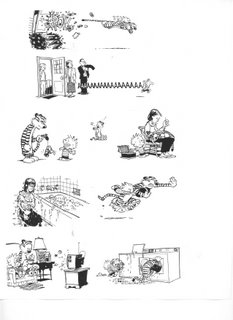The Collaborator, the Prima Donna, and the Fanboy

Last Tuesday night a couple of my students pulled me aside after class and asked if I could post something on "how to interview well." I talked with them a bit about it and basically came to the assumption that this could be a very tricky thing to talk about. I just don't know if I can give general advice to people who will be interviewing at many different places. One general idea I came up with was that you'd most likely want to come across as someone who will work well in a team, and that is what I will focus this post on.
I had an acting teacher tell me once that the greatest actors are ones who are "giving" to the other actors on stage. If a performer wants to "steal the show" they are not giving, but taking away from the other performances and story by hogging the spotlight. I believe this is true for animators as well. Both require performances that build; that ebb & flow with the story. Don't get me wrong; it is always an artist's duty to give the audience nothing but their best. But that best work, if done in a collaborative environment, will give the other performers something to REACT to. Feature animated films have definitely fallen into this trap in the past, where animation has stepped into the spotlight over a great story. This also happens all the time in live action movies as well. How many movies these days let the special effects take the spotlight even over the actors and story?
When I'm interviewing someone, I'm looking for someone who has amazing work as an individual (their reel!) AND seems to have a great attitude about sharing ideas with others. Personally, I don't want to work with a "superstar" animator if he/she is an egotistical prima donna. The animation department we have here is like a family that shares ideas and inspires one another. I've actually heard an artist say in an interview that they had nothing more to learn; that they wanted to show others how they knew great animation should be done. Nope, not interested. Some of the greatest animators I know are very humble artists that admit they still have something to learn, and seek the advice of those around them to push their work further.
The opposite of the superstar is the superfan. This person is someone who is more into the idea of working at a "famous" place, rather than loving the craft of animation and collaborating on telling a great story. Personally, I don't do what I do because of the name of the place I work at. I love cartoons, movies, animation, acting, teaching, and learning. I am passionate about what I do and I love working with others that feel the same way. I understand that it is the student's job to be excited and inspired about what they are doing, but I warn them not to be fanatical. Animation doesn't beget great animation. Great animation comes from being inspired by things observed in real life.
If you have been called in for an interview your work has probably shown an ability to stand alone. Be proud of that! But for the interview I recommend simply being yourself. You will show either that a) you're a fanatic so much that it'll freak people out, b) you're an egotistical jerk that should work someplace else, or c) your someone who will share ideas and work well on a team. I always go for c.
Another two cents from Dr. Sclark.




